Chris & Allyson vs. Australia (May 2012)
Day Three: Swimming with sharks in Manly. A visit to Bondi Beach.
Climbing a bridge is fun; so is visiting a landmark building like the Opera House. But neither of those activities involve the risk of having your face chewed off, and it's not a vacation without that risk. So on our third day in Australia, we swam with sharks.
Allyson had wanted to do this for some time. Her original hope was to swim with sharks on the Great Barrier Reef, and as soon as she revealed this to friends, we received a number of very helpful Internet links to Australia shark attack stories. I did a little research of my own, and I figured out that getting scuba certified, transported to a shark-friendly location and diving for a few hours costs exactly way, way more than I want to pay.
And I wasn't gung-ho about the idea before that. Swimming with dolphins? Sure. Dolphin stories are usually happy. They save you from drowning, or teach you how to cope with the boating-accident death of your mom. Occasionally they'll sexually assault a diver, but even then it's about the love.
For sharks, all the stories are bad, because sharks are genetic killing machines. They have dead eyes and more teeth than they need. Nothing on their bodies qualifies as cute, they don't make fun noises and they don't have any hobbies, like balancing beach balls on their noses. If sharks were people, they would be Daniel Day-Lewis, as he prepares to play a shark. That's how intense they are.
But Allyson called me a pussy, so I had to do it. My wife weighs about 100 pounds, and she has a rod in her spine from scoliosis-related back surgery; strenuous activity that tires out her stabilizing muscles actually causes her internal organs to move around. She also suffers from chronic double vision. So if she wants to scuba, guess what? We're gonna scuba.
Allyson found a small aquarium in Sydney that did no-experience-necessary shark dives, which made things kind of acceptable -- if tourists were dying in significant numbers in Australia's aquariums while young children looked on, you probably would have read about it. I was still a little nervous, but otherwise willing. All we had to do was get there. We were headed to Manly, a fine little suburb with the harbor on one side and the South Pacific on the other. The best way to get there was by ferry.
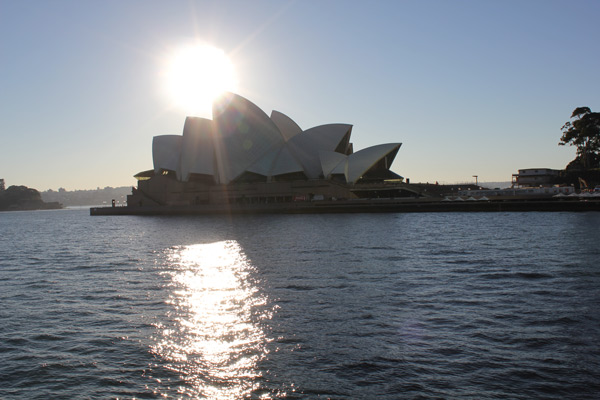
A view of the Opera House from the Manly ferry.
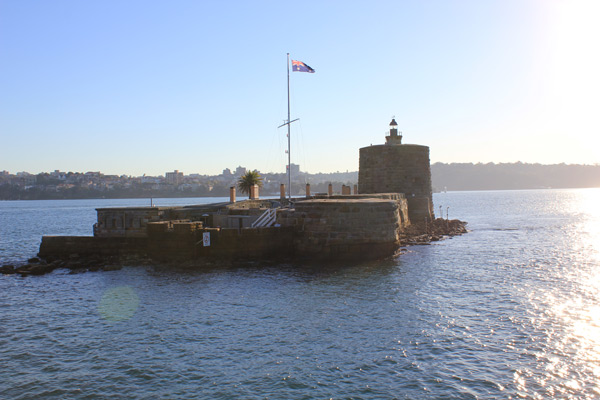
One of the harbor fortifications, seen from the Manly ferry.
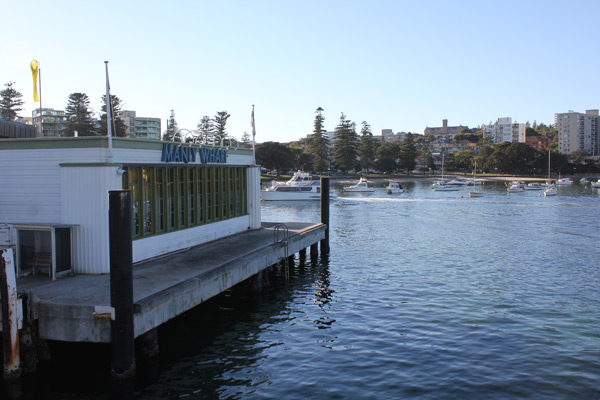
End of the line. Docking at the suburb of Manly.
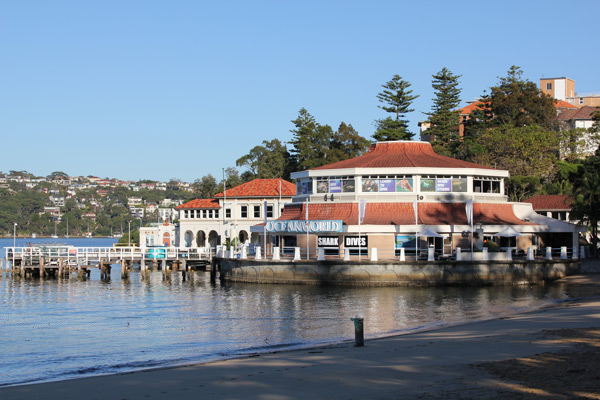
An aquarium where you can swim with sharks, with no experience whatsoever!
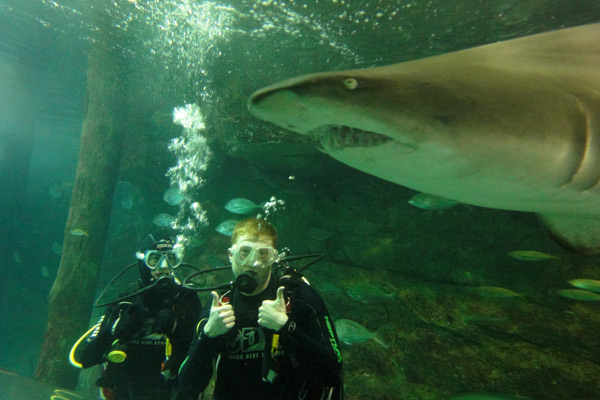
Anything worth doing is worth doing well.
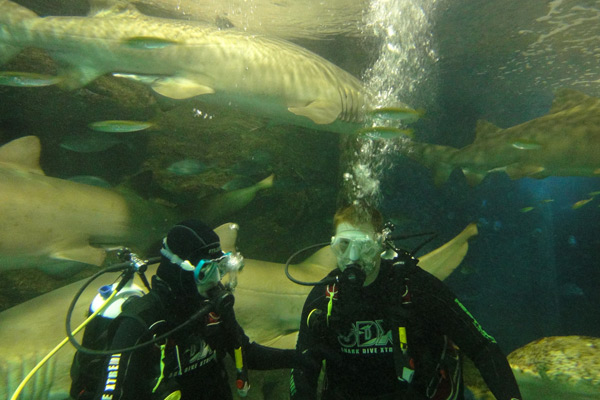
They're relatively harmless, but this was still sporadically terrifying.
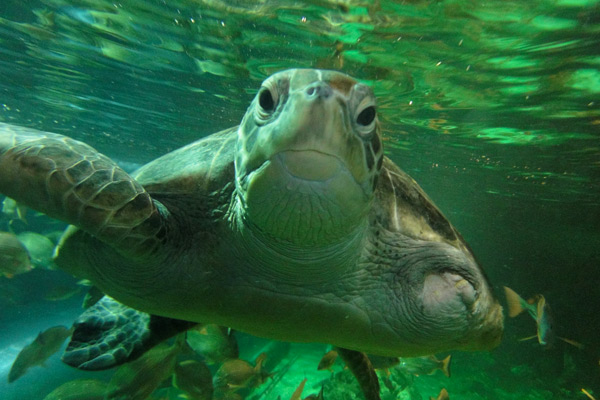
The turtle was an added bonus.
Some people ride ferries in Sydney like we'd ride a bus to work; if you live there, it's part of your daily grind. We were riding away from the business district, though, so those killjoys weren't on our adorable little ship. Allyson and I grabbed seats outside, on the front of the boat, and for the next 30 minutes we got ourselves a cheap public-transportation photo safari. The Manly ferry goes past the Opera House, along the botanic gardens and out to the middle of the harbor. It takes you past Fort Denison, the ultra-mini-Alcatraz where they tossed the convict laborers who got out of line. It takes you past lighthouses and cargo ships and windsurfers and buoys, all with just the right amount of lens flare as the morning sun bounces off the water.
And of course, it takes you past dolphins. Fun-loving, carefree dolphins with no interest in wearing your intestines like a lei.
We had planned 15 minutes to walk from Manly Wharf to the aquarium once known as Oceanworld. We needed about 60 seconds, because Manly is "quaint." Oceanworld is also quaint, and in no way on the scale you would expect from a name like Oceanworld. (It had been purchased, and was being renovated when we visited.) We sat by the door for a few minutes, when someone finally poked their heads out and asked if we were there for the shark dive. They were waiting on another couple to show up and join us, but once they arrived, we could proceed in an orderly fashion to filling out our wills and the other usual precautions.
That couple never showed, so once again it was Chris and Allyson vs. the world. And sharks.
Our handler for this particular adventure was a guy named Christian, an Australian dude with a nice mop of curly hair and an easygoing manner. I forget the exact estimate, but he calculated that at least a year of his life had been spent underwater. I liked him, and after we filled out a clipboard of "we can never sue you ever" forms, he taught us how to scuba.
Scuba is a strange thing. If you want to be certified, you can take a two-day course involving some video-watching and test-taking; then after a few open-water dives in the abandoned quarry of your choice, you're an expert. Certification lasts forever, and apparently supersedes the laws of sovereign nations. If we one day travel to a distant alien planet, and their lakes do not instantly incinerate human flesh, you will be allowed to scuba in those lakes. The Council of Scuba Elders has achieved what the United Nations never could. Armed with your certification (probably a few thousand bucks when you factor in the equipment rentals and bribes), you are entitled to swim around unsupervised with the ax murderers of the aquatic kingdom, at slightly less expense than if you took an instructor along as a potential human shield.
We didn't get certified before coming to Australia, but a 10-minute video about hand signals and some quick in-pool instruction are all you need to pass the smell test. We had to demonstrate three skills before they let us into the aquarium tank: expelling water from a mouthpiece (or rebreather); clearing water from goggles; and fitting into a wet suit. I was happy to wear just the wet suit, but Allyson has significantly less "natural insulation" than I do, so she opted for a hood and gloves as well. She looked like a ninja, if ninjas wore weight belts and oxygen tanks and shivered a lot. The hard part is not panicking as you realize that you've been underwater for a minute. You'll want to gasp and take deep breaths, but the absolute best thing is to breathe slowly and normally. Otherwise, the sharks will smell your fear. Fear is a shark appetizer.
As to the actual adventure: Christian took us into the main tank, which had one of those tunnels that lets people walk below as fish and stupid American tourists swim above. There was a brief orientation period, where we failed to find our centers of gravity in this exciting underwater world. Then we hopped over the tunnel and walked along the tank to the place "where the sharks like to hang out."
The sharks in this case were nurse sharks, which are mostly harmless despite looking like Satan's errand boys. Christian told us that a few people had been bitten, mostly because they agitated the sharks or looked delicious; we made a point of avoiding them as much as humanly possible. We mostly stood on a small ledge on the edge of the tunnel, then leaned over the tunnel for stability. This gave the people in the tunnel below an excellent view of my midsection in a wetsuit; it also put us in prime shark-watching position. The fish come to you.
Or right at you. Allyson and I both fell off our ledge when a nurse shark buzzed our faces, then took a right turn to swim directly between us. It's a good feeling, as you're falling slowly through the water, to realize that you might land on one of the sharks that hangs out on the bottom of the tank, and that he might eat you. It's a better feeling when none of that happens, and you also didn't pee in your wetsuit from terror. What's more, we could only look ahead with any ease; when we later looked at the photos Christian had taken, they showed the shark family reunion that was going on behind our heads. I thought maybe this experience would change my outlook on life -- you can't really judge a shark until you look him in the eye. Having done so repeatedly, I now feel comfortable that sharks are definitely soulless killing instruments. I wouldn't say so directly to a shark's face, on account of the scuba equipment getting in the way. But I know this to be true.
After 20 minutes of tempting fate, we made our way back. Since our exit time corresponded with feeding time, and people in scuba gear usually feed the fish, they mobbed us on our way out of the tank. We saw a sea turtle up close, hundreds of fish wished us goodbye, and I was practically molested by a stingray. He was slimy and disgusting, and every time I eat poorly prepared sushi I shall think of him. After we got out, it was just a small matter of peeling ourselves from our wetsuits, paying more than $100 for the underwater photos, and thanking the shark gods for their tolerance. The consensus was that it was totally worth it.
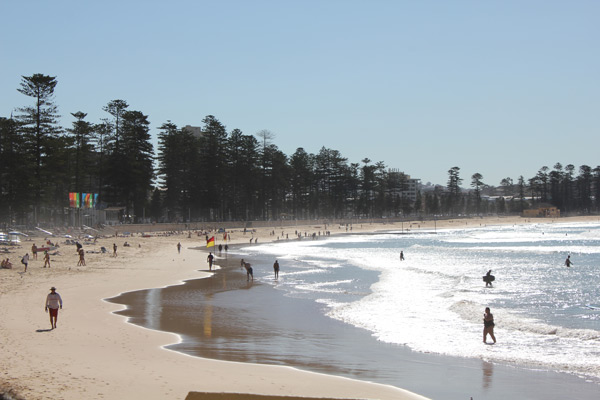
Manly beach, one of the most popular leisure spots in the Sydney metro area.
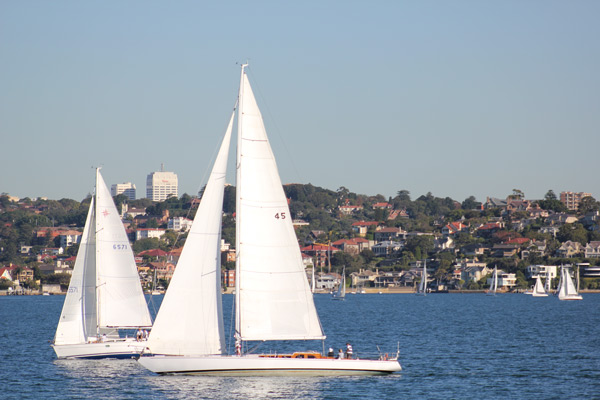
Sailboats on Sydney Harbor, as seen on the ride "home" from Manly.
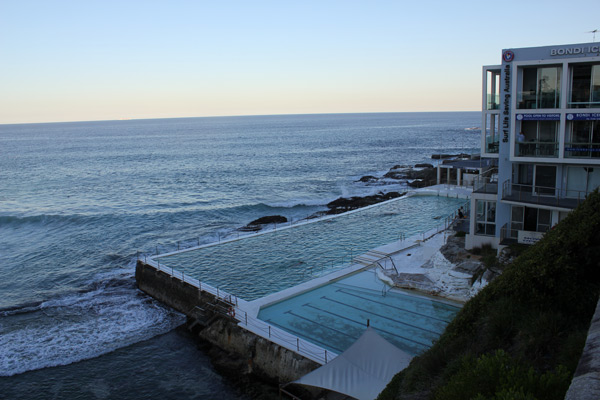
One of the world-famous swim clubs at Bondi Beach.
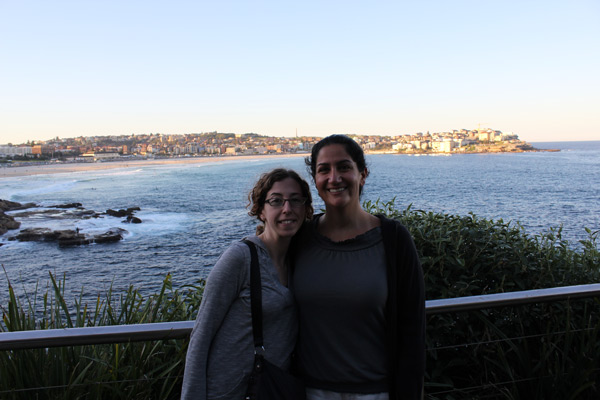
Friends on the Bondi Beach walk.
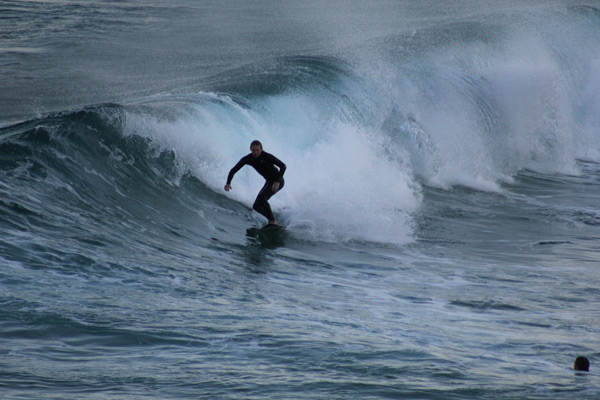
Surfers getting some reps in after work and before the sunset at Bondi.
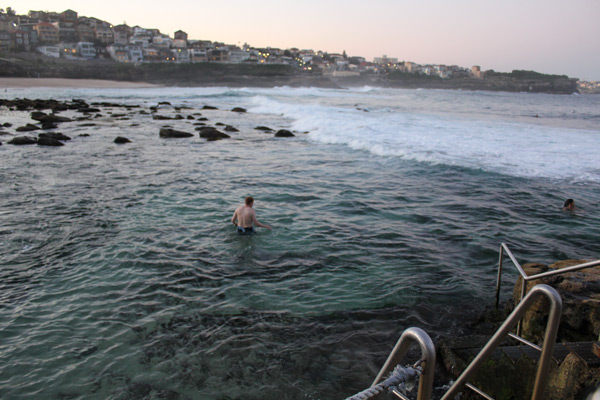
One of the stunning public swimming areas on the Bondi Beach walk.
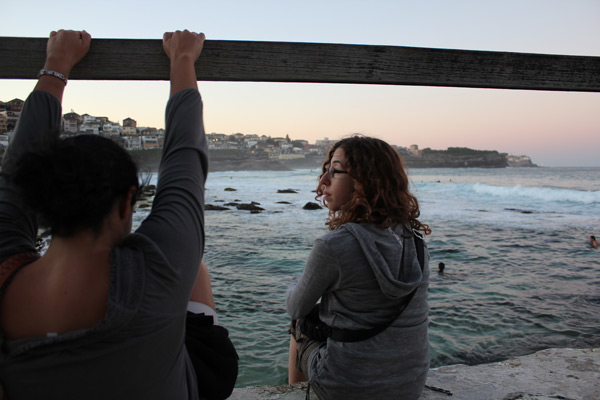
Looking out across the waves at Bondi.
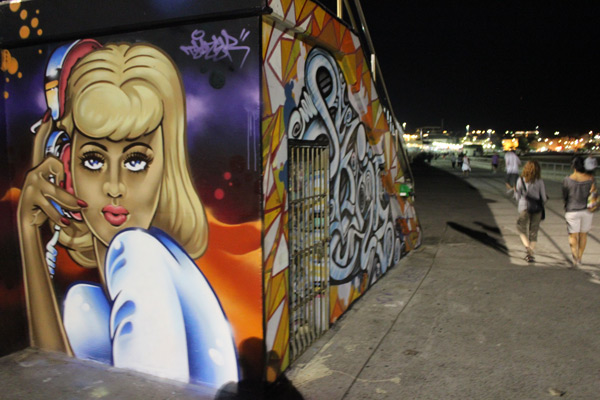
Street art along the Bondi boardwalk.
All this madness got us to lunch, and I had earned a beer, even at Australian beer prices. Still a little giddy from our shark dive -- and the ear infection that I had picked up somewhere in there -- we walked a few blocks to have lunch at 4 Pines, a microbrewery right across from the wharf. We were the only people there, and after a two-beer burger-fest we decided to see what Australia's beaches are all about.
They're not that far removed from the Jersey shore. We strolled down The Corso, a pedestrian mall taking you from the harbor to the ocean. In time-honored beach tradition, it was filled with crappy food places, awful souvenir stands and overpriced beachwear shops. If you start building homes anywhere near a beach, these things will sprout from the soil. It's the way nature planned it.
A quick note on souvenirs: One friend, jokingly, had asked us to get her a koala in a diaper. For two weeks, we looked at every rat-trap tourist stand we passed. We found koalas in wedding attire, koalas that you could clip onto a pencil, koalas in Bridge Climb jumpsuits and koalas in the buff. We did not purchase too much in the way of generic souvenirs, but we could have gotten: kangaroo nut-sack change purses; kangaroo-skin rugs; "authentic" didgeridoos and boomerangs by "authentic" aboriginal craftsmen; stuffed kangaroo dolls; stuffed wombat dolls; Australian-themed jerky; crocodile skins; ugg boots of many varieties; and much, much more. There were no koalas in diapers. We debated buying an Australian flag handkerchief and tying our own diaper, but it was ultimately decided that this was dumb, even by my standards.
But back to the beach. Manly has nice waves and the surfers to match. At the height of beach season you can't find two square inches to lay down, because the Aussies are a water-loving people, at least for the few months where their oceans aren't infested with deadly stinging jellyfish. Allyson and I were there in the off-season on a Wednesday, so we didn't have to wrestle anyone for a spot on the sand. After watching the tide, we strolled about a mile to Shelly Beach, then made our way back to the wharf. I could sit on a beach all day, doing practically nothing. But we didn't have that luxury. We had to get back on the ferry, so we could go see another beach.
Before we got there, the ferry ride back was another adventure. Apparently, Wednesday afternoon is when everyone takes their sailboat out on the harbor. For the whole ride back, we had a wonderful view of the Japanese gentleman who decided to stand at the front of the boat for 30 minutes taking pictures of those boats, while blocking everyone else's view. He muscled aside two girls who couldn't have been more than 7. Several occasions on our trip we saw Asian tourists acting like paparazzi, only for waterfalls and sailboats. You want to keep an open mind, but after you've been nearly trampled to death by 20 camera-wielding Chinese people, you open your heart and let the stereotype in. Thank you, sailboat photography guy. The memory of your comb-over will last me far longer than fleeting thoughts of the catamarans on Sydney Harbor.
But back to the other beach. From Circular Quay, we took a very exciting bus ride, all the way to the office of our good friend Goli. She had graciously agreed to cut out of work early and show us around world famous Bondi Beach -- home of the 2000 Olympics beach volleyball competition. Anyone who saw those never-ending TV close-ups of "hand signals" during the women's matches, which were conveniently in front of huge wedgies, could never forget such a magical place.
Bondi Beach is essentially Manly Beach, but bigger and with more attitude. It knows it's popular. The first thing we walked past after getting off the Bondi bus was the Iceberg Club. Australians are avid swimmers, and the Iceberg Club is like the Augusta National of pools. Aussies often build saltwater pools jutting right into the ocean, with just a small sea wall protecting patrons from sharks and jellyfish; you get a gorgeous natural setting without the threat of paralysis or death. On a continent where nature is constantly trying to commit first degree murder, that's gotta be insanely relaxing.
We saw people enjoying the regular ocean, too. Goli took us on the famous Bondi beach walk, a coastal path that takes you along cliffs and beaches. We were taking it all in, and being passed by joggers with negative 2 percent body fat, as the sun was going down. There were surfers out taking advantage of the last bit of sunlight, and folks diving into the waves. Somewhere around Bronte Beach, it seemed stupid not to join in the fun. Since I was still wearing my shark-diving bathing suit, I decided to try an ocean-side pool. Allyson and Goli were polite enough to not shriek in horror when I removed my shirt, and for the first time in my life I took a dip in the Southern Hemisphere. It was a pleasant experience for everyone who didn't have to look at my shirtless form.
On the walk back, we enjoyed the stars of the southern sky, then had dinner at North Bondi Italian. Allyson got a little sick, but I'm not sure it was the food. It might have been that she missed the sharks, and deep down inside, she knew the sharks missed her.
Or not. Remember, they're heartless murder machines.
